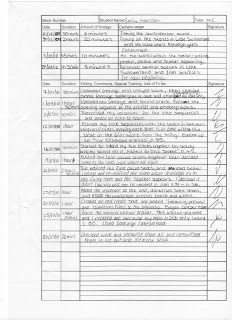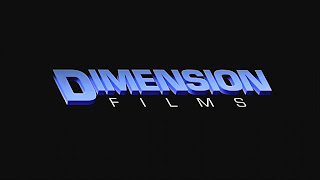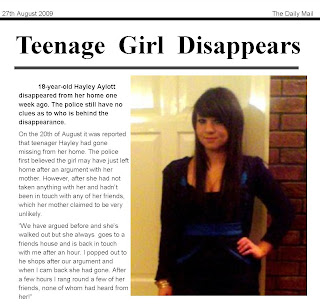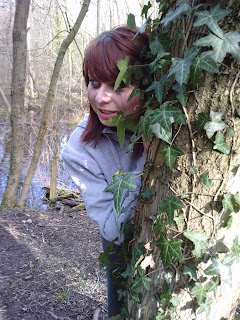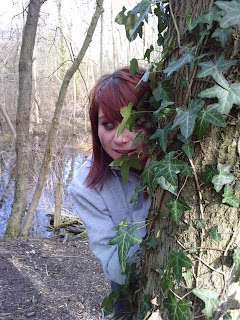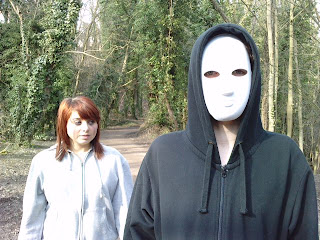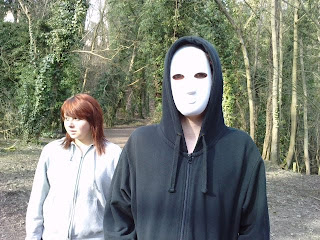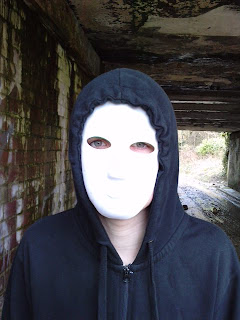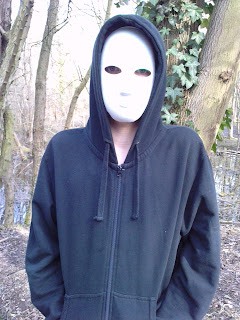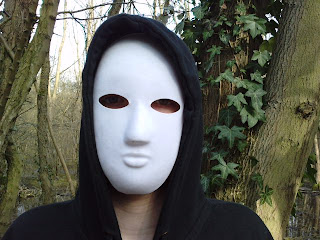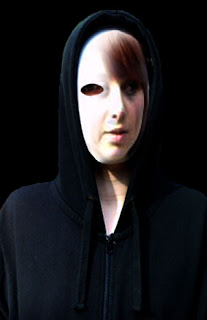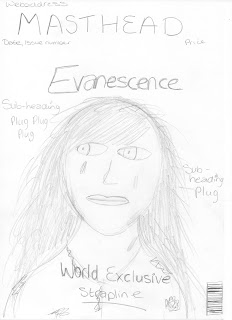For my A2 Advanced Portfolio in media I chose the following brief:
A promotion package for a new film, to include a teaser trailer, together with two of the following three options:
• a website homepage for the film;
• a film magazine front cover, featuring the film;
• a poster for the film.
I worked individually on this project and had to make sure I completed the work within the brief. To help me create my work I had to research, plan and develop my ideas to ensure I had been thorough enough before starting to create my products and evaluate them. The task set was a lot more complex than my first year coursework, which was to create a music magazine front cover, double page spread and contents page. My second year coursework involved learning how to use more advanced technical equipment, for example a camera and editing suite. However the work and skills I learned in my foundation portfolio helped me to create my two ancillary texts. I decided to create a film magazine front cover and poster. I did not choose to do a website homepage because I have no prior knowledge about computer design.
When I started my planning and research for my main product I looked at how the media concepts could be applied to my trailer using the acronym “LIIAR”. The language used in my trailer is very important to help it be received by my target audience, and address them in the correct way. The language included is things such as a voice over to help set the equilibrium, or a title sequence. However it was also important that I understood and used the correct language and terminology in all stage of my production; for example, the language of the moving image, medium shots, close ups etc. It was fundamental that I knew the correct terminology and understood what it meant so that I could use the correct elements in my trailer. The institution of my trailer is the production company of my film. I used Dimension Films because they are a well known production company and have produced other horror films such as Amityville Horror, 1408, Scary Movie and all the sequels. The ideology is the ideas, morals and values within my film. The ideology behind my trailer is the main idea of it, e.g. the narrative and making sure it is interesting. However the main idea of my trailer is also to ensure it promotes the film and make the audience want to go and watch the film. The audience for my trailer depended entirely on the genre I chose, I did some audience research and found that my target audience is both males and females aged 15-21. Representation was also a key concept in my production. Everything in my trailer is representation, the characters, the mise-en-scene, cinematography and the editing; all of these elements of my trailer had to represent the genre of horror in order to maintain audience expectations.
After looking at the media key concepts and how they could be applied to my trailer, I decided to research the history of film trailers to help me have a greater knowledge of the background. I felt that building up my knowledge of film trailers would help me when it came to planning my own.
It was important that I used the reception theory to create a preferred understanding. Each individual reads a text differently depending on their circumstances, so there can be major differences between readings of the same code. Therefore by using recognised codes and conventions, and outlining audience expectations on aspects such as genre, there will be an amount of agreement and understanding of what the code means. Hence the importance of thorough research into codes and conventions of existing texts. I analysed several genres of film trailers to see what conventions appeared throughout all trailers. I then decided what genre I wanted my trailer to be and selected to do a horror. After looking at several different genres I personally felt that horror had lots of conventions that would be easy to create in my trailer. I thought it would be difficult to do another genre, just as comedy, because obviously the main convention is humour, which I felt would be difficult to produce and portray because everyone has a different sense of humour. It would be very easy for something that was funny to one person to be the opposite to others.
Once I’d decided on my genre I researched the history of horror films to find out what type of horror has been popular throughout the years. I felt this would help me when it came to planning and developing my ideas as it would allow me what has been successful and what hasn’t. From my previous analysis from across genres I noticed there were several reoccurring elements and conventions such as, end credits, release dates, name of the film, names of actors etc. However to help me find conventions of the representation of the horror genre it was essential I did some more analysis’ but this time focusing completely on horror. When analysing existing horror trailers I looked at four main areas; mise-en-scene, cinematography, editing and sound. Several of the conventions I noticed were; darkness, scary villain or the unknown, a variety of shots and angles to create disorientation, slow paced editing getting faster towards the end with a short montage, dramatic music, sound effects e.g. screaming, and tension/suspense. There were several other conventions but see my earlier posts for more details. To help ensure I used as many of these conventions as possible I started to create a mind map of ideas.
To identify my target audience was very important before I started developing my ideas because I wanted to make sure my trailer would be aimed at the right people. I created a questionnaire and handed it out to a random selection people. I organised all my results into pie charts so that they were clear. I found that my target audience is both male and female aged 15-21; they visit the cinema often as a way of socialising with friends. To help me get a further idea of my target audience I found that the cinema is the preferred way of watching a film instead of at home and buying DVDs is more popular than downloading films. To help me meet audience expectations and reflect the industry, I asked my target audience what aspect of a trailer makes them want to go and watch a film and what elements make a good horror film. My results show that the key factor in making a good horror trailer is suspense and tension; these were reoccurring factors in answer to both questions. Other popular answers were plot, actors/actresses, a twist/the unexpected, believability and a creepy killer/bad guy. My audience research post shows my results and findings in more detail.
When I developed my synopsis and storyboard I used all my findings and results to ensure that I used conventions and expectations of my target audience. I decided that my trailer would have a believable storyline to it because this would add more suspense and tension as audiences are more scared by things that could actually happen, instead of something that could be seen as unlikely to happen, for example, abduction by aliens or possession. I decided that my film would be about disappearances and the mystery behind them. Therefore I used the title Evanescence which means “the event of fading and gradually vanishing from sight”, I felt this would be appropriate title for my film because it links in with my plot, a group of girls who are gradually vanishing one by one with no clues. A convention of a horror is to have a “scary bad guy”; I decided to create a stalker who is behind the disappearances. To make him more conventional I created a stalker that wore a plain white mask. This is intertextual of several previous films; an example of one would be Halloween. A mask is a code for a villain, when audiences see a mask they instantly know the character behind the mask is causing the disruption, whether it is disappearances or murders, because they want their identity to be hidden. I cast my other main character as a teenage girl, this is another convention of horror films, a lot of horror films are based on teenagers getting themselves into deathly situations, an example is Friday the 13th.
Before I started filming I made sure I had a storyboard, script, location, prop and cast list. I also completed a health and safety assessment to make sure any possible hazards could be prevented. I decided to use several locations for my horror trailer. The main one was Little Switzerland which is a public country park on Hessle Foreshore; it has lots of woodland area as well as several railway bridges which I felt would be a perfect location for filming my trailer because it is secluded. The area has lots of different pathways so it was possible to film in various locations. It was important I picked the right location because the mise-en-scene reflects the genre. My location is a convention of horror because a lot of horror films are often in deserted, spooky and remote areas, and Little Switzerland portrayed this perfectly.
I developed a lot of skills when it came to filming; I learned how to use the camera and how to frame a shot. The technical skills required this year have taken a massive leap from the skills required last year. I filmed a total of around 35 minutes worth of footage. I made sure that I re filmed each shot a few times in case it didn’t come out as well as I had hoped the first time. I made sure I filmed in the day because the quality wouldn’t have been very good if I had filmed at night. A convention of horror is darkness, so I therefore made sure that once it came to editing my trailer I darkened all the shots.
I changed my original idea for the opening, instead of having a news reporter disclosing the information about the disappearances and then later having a shot of Ashleigh looking at several newspaper reports, I decided to film different newspaper headlines. I had wanted to create the feeling of a crime scene; Ashleigh is supposed to be the sixth disappearance therefore the news reporter is reporting from outside her house. When I uploaded the footage the dialogue was really quite and the medium close up shot was very boring. So I therefore decided to completely change my opening.
I edited all the newspaper reports together in a sequence, making sure I set the basis up of the narrative, but not giving too much away. I feel the beginning of my trailer is much stronger and more effective than it would have been with my original idea. Having headlines at the beginning of my trailer will help focus the audiences’ attention because they have to read the headlines to help them understand the narrative of the film. I believe the narrative of my trailer has carefully been thought through in order to make sure it makes sense. The newspaper articles at the beginning set up the storyline about the disappearances; however they only state five girls have gone missing. I used a picture of myself in one of the articles so that when Ashleigh is later looking at a photo of herself and me it shows that I am the “One friend” that is referred to in the title sequence. Ashleigh also later goes missing and audiences realise another disappearance is about to happen because one of the title sequences says “Six disappearances”. The last title sequence, “One Secret” leaves audiences asking the question of what is the one secret. This creates suspense.
I used Adobe Premiere Pro 1.5 to edit my trailer, it is a non-linear editing system which made it a lot easier to edit. It allowed me to easily take shots out whenever I wanted to and meant I could edit in a non-linear format. When I was developing my ideas I chose the film score to The Thing as it has a strong dramatic beat to it, I was planning on using this song all the way through, however when I started editing I realised that to follow conventions I needed to later bring in a faster paced song and quicken my editing. I edited the opening of my trailer to The Thing and made sure each shot was in time with the next beat. I feel this gives my trailer a more dramatic atmosphere. When I analysed the existing trailers earlier the sound was a very important element. A trailer would not be complete without a soundtrack or sound effects; therefore I had to make sure my music fitted perfectly with my editing. Making sure each shot was in time with the beat was difficult and took time, however I think the end result of the sound is the strongest element of my trailer. Just before the title sequences finish I started to merge my second song by Hadouken called Rebirth. This song has strong drum and base in it which gives the trailer a dramatic feel. The track is a lot faster than the first one, it speeds the trailer up so I therefore quickened my editing, using lots of short, sharp, cuts in between shots. This is conventional to horror trailers; they speed up and get more dramatic in the second half.
As you can see in a previous blog “first edit” I decided not to use some of the footage that I filmed. I felt a lot of my shots where medium shots and this looked very boring; I wanted to create a montage of quick and disorientated shots. Therefore I re-edited the second half of my trailer and made sure I used different angled shots rather than just using medium shots using other types like close ups. I wanted to use a variety of shots to add speed and disorientation to my trailer. I use lots of quick cuts and fades to create sharper and quicker shots.
When I had finished my editing my trailer together I darkened all the shots, however some of them did not darken as well as I would have hoped, because they were very light in the first place and I didn’t want to darken them too much and loose quality of my video. I have used a voiceover in my trailer which I editing in adobe and added an echo on it to make it sound more dramatic and authoritative.
My final edit uses several conventions of horror trailers; suspense, fast paced editing, dramatic music, creepy bad guy, dark shots, montage, various angles and shots, secluded location and leaves the audience asking a question. I made sure I used appropriate sound, mise-en-scene, editing and cinematography. All of these elements signify to the audience that my trailer is representing the genre of horror. It achieves audience communication by using the reception theory and the preferred reading.
I also did research and planning for my ancillary texts to ensure that I found out what codes and conventions are used within film posters and magazine front covers. I was at an advantage when it came to the magazine front cover as for our foundation portfolio last year we had to create a music magazine. Even though for my advanced portfolio I had to create a film magazine rather than a music magazine, some of the conventions overlap. I learned skills in my foundation portfolio on Microsoft Publisher and Adobe Photoshop CS3 which aided me in my production this year.
For my first ancillary text I created a film poster in Microsoft publisher. From my research and planning I found that the most important element of a horror film poster was a simple but effective picture. Film posters are entirely visual and the picture needs to be effective. The picture will represent the genre and is always the main focal point of a poster. From analysing previous texts I found that the other conventions of film posters are large title, tagline which has to be catchy, two or three main colours which are conventionally dark and credits.
My finished poster is very simple; however it uses all the conventions of horror posters. For the photograph I decided to use a simple shot of the mask. The mask is iconic to my trailer. I wanted a simple but effective image and I thought that a photo of the mask by itself on a dark background would achieve this. I used Photoshop to darken the edges around the mask; I had originally taken the photo on a dark background however it wasn’t as dark as I would have hoped.
I had to make sure that the form and structure of my poster was correct because otherwise it could create an alternate meaning. For example if in my form I had used an image that did not represent horror the poster could be interpreted to be a different genre. Therefore it was essential I followed and used the correct conventions. I had to make sure there was a tangible link between all of my texts; therefore I created the title in Photoshop. Photoshop is an adobe programme and therefore had the same font on it as the Premiere Pro editing suite. I used the same font for my tagline, “You can run, but you can’t hide!” I decided to use this as a tagline because this, along with my image, gives the audience some idea about the narrative of my film. I also decide to create some credits and place them along the very bottom of my poster; they are conventionally the element that is noticed the least on film posters.
For my second ancillary text I had to create a film magazine front cover, featuring my film. I created this in Microsoft Publisher and adapted my photo in Photoshop. I took a photo with both characters in and blurred their faces together. This creates a scary image and looks like one face at first glance until you take a closer look and realise I have blurred the face of Ashleigh with the mask. My research and planning for magazine front covers show that the most important element, like on the posters, is the main image. The magazine is featuring my film therefore it has to be the main focus of the cover.
I decided to call my magazine “The Rush” this can represent the first print from a film, before any editing or changes have happened. I thought it would be appropriate for my magazine as it could suggest that the magazine has the most up to date and exclusive information about films. It could also refer to the rush of excitement you experience when seeing a film at the cinema. I used white font for my title because I wanted it to stand off the dark background. I also made sure I used the same logo that I had used in my previous texts. From my research and planning I discovered that conventionally magazine front covers stick to three colours. I therefore only used three; white, red and black. I used black because it represents darkness, white because it stands out against the black and reflects the white of the mask and red because it represents danger and blood. I had to make sure the magazine front cover represented my film to be a horror, hence my choice of colours.
I had to make sure the form and structure was conventional so that it would signify the right meaning to audiences. The magazine front cover is promoting my trailer so has to communicate the right genre and impression that I want to be received. I therefore added other conventions to the structure of my magazine front cover so audiences can definitely tell that it is a magazine front cover. Some of the other conventions I used where subheadings, barcode, date, issue number and magazine website. I checked the availably of the website “www.thelatestrush.co.uk” at www.123-reg.co.uk.
I made sure that there is a tangible link between all three of my texts to ensure that they work well together as a promotional package. I used dark colours and iconic features so that they will be recognised by audiences. I made sure that the logo of “Evanescence” is used throughout. The mask is the icon of my film and is included within all three texts. I think my three texts are effective in promoting my film. However, I feel my two ancillary texts are not as strong as my trailer. A trailer has so many codes and conventions within different areas, such as sound, whereas, my two ancillary texts had to represent my film through only visual elements. I used all the conventions of both poster and magazines; however I do not feel they are as effective as my main product.
For my audience feedback I created a questionnaire and handed it out to a random selection of people of all ages however made sure I aimed it more at my target audience as it was their opinions and feedback that was of the most interest to me.

My feedback has been very helpful and has showed me what areas I would need to improve on if I was to do the task again. I got a mixture of positive and negative feedback; however all the negative feedback has suggestions of improvement next to it. Everyone said they enjoyed watching my trailer however not everyone said they would go and watch it as a film. Some people suggested that more needed to be given away as to where the narrative would go, however the majority of people said that the trailer would want to make them go and watch the film if it was real. I asked my audience if they thought my three texts represented the genre of horror, everyone answered yes to my two ancillary texts and the majority said yes to my trailer; however some people said it could be seen as a thriller and suspense instead of a horror. I feel that thrillers and suspense’s closely overlap with horror; there are several features that are the same.
When asked if there was a tangible link between all three texts, everyone answered yes and when asked to rate how effective they thought my three texts where as a promotion package (1 being the lowest) my audience gave an average score of 3.5. I also asked my audience to rate the quality of my film trailer and my two ancillary texts. My trailer scored higher than my two ancillary texts, on average my trailer scored a 4 and my two ancillary texts scored a 3. This has been a very helpful part of my audience research as it has helped me to see that my ancillary texts are the weaker areas.
My final question asked if they thought my three texts could be used as a real production. The majority of people answered no and some of the suggestions left to me were:
• my ancillary texts let me down because they did not look professional enough.
• the quality of my camera when filming needed to be better.
• the editing at the end of my trailer needed to be quicker and include more shots.
Some people left additional comments at the bottom with positive feedback, some of the comments that were left stated how well thought up the narrative of my trailer was and the use of newspaper titles. Another comment left was that the music was a very strong element in my trailer.
I have had to use a lot more media technologies for my advanced portfolio than I did for my foundation portfolio. However some of the skills I gained last year have helped me this year for example my skills on Photoshop, Publisher and blogger. I used all of these media technologies within my productions of both portfolios. My advanced portfolio has required me to use media technologies in all stages. For my research and planning I analysed existing texts for which I used You Tube for existing film trailers. You tube allowed me to stream previous film trailers without having to download them; this made it much easy and quicker to analysis. All of the stages, research and planning, construction and evaluation, have had to be done on blogger. This has been a simple way of keeping my coursework as it has been easy to change things if necessary. However it has been very frustrating to use at times because sometimes it runs slow or on some computers at college it was blocked, making it difficult to access sometimes when needed. For my construction I used various technologies such as a camera, Adobe Premier Pro 1.5, Publisher and Photoshop, all of which I have mentioned previously in my evaluation. By using these programmes it has helped me gain new skills and extend others. All the media technologies have helped me achieve and create my coursework. I feel that if I was to do my advanced portfolio again with the knowledge and experience I have gained from using these technologies I would be at a much better advantage than I was when I started.
Audience expectations have been the most important factor to consider throughout my portfolio. They have helped develop and create my ideas; they have been like rough guidelines of things I need to make sure I included. I feel that I have included all of the conventions and expectations within all three of my texts; however some of them could be improved. For my main product, the trailer, I strongly believe that the sound and mise-en-scene where the strongest elements. I created an original sound track by using two intertextual references to other soundtracks. One is from the film The Thing and my other song is called Rebirth by a band named Hadouken. I feel that both the songs work well together and create different atmospheres. The first one, The Thing, is slow and is played while the narrative builds up, as it does the second song, Rebirth, is brought in and the two are mixed together, until The Thing dies out completely and there is only the fast paced music. However one thing I would say that is letting me down about my sound is the voiceovers. If I was to change anything about the sound I would make the voiceover at the end sound more realistic and scared. Another strong point is the effect my editing has on my sound. I have edited my shots very closely to the music, especially at the beginning which makes my trailer more dramatic and professional because it is edited continuously to the music.
I also feel that I used appropriate mise-en-scene; this form affects the meaning of the trailer. It was important that I used the correct mise-en-scene to represent the genre. I feel that the secluded and isolated feeling of Little Switzerland was the perfect location and mise-en-scene for my trailer. It is conventional for horror films to be set in locations that have these characteristics and I feel I have reflected them well. For example in Friday the 13th, is set in a wood, similar to the location I had chosen.
I feel that the cinematography let me in my main product. Some of the shots did not come out as well as I would have hoped. I believe my ideas for scenes and shots work well together but the outcome is not what I wanted. If I was to redo this portfolio again I would dedicate more time to filming and finding better actors and people willing to follow my directions. I found it difficult to find someone that was willing to create the atmosphere I needed. I needed the main character Ashleigh to look more fearful and dramatic, however because I did not have someone willing to follow my directions exactly I found it difficult to direct the shots. I have made sure that I have used a variety of shots and angles, however if I was to redo my trailer I would use even more variety. I also filmed in the day so that the quality would be better however I did not realise it would be so difficult to darken the shots on Adobe without losing quality. I therefore feel that some of my shots are not dark enough and darkness is a key convention of horror. If light shots are used it could affect meaning and how effective the overall trailer is.
When considering audience expectations within my ancillary texts I have used all the conventions of posters and magazines. However I feel these conventions are not strong enough. I particularly feel that my magazine lets my promotional package down. I think my picture is effective and is conventional because it shows the main characters and when I researched previous film magazine covers all featured films on the cover had an image of the main character. I have also followed the convention of sticking to three colours, however I feel my magazine looks slightly boring and has little colour to it. The subheadings are in red which represents the genre of horror, so even though I have stuck to representation and the convention of sub headings, I feel it could have been improved by using a different font.
I also feel that the font lets me down on my poster and it could be improved. However I had to make sure that there was a clear link between all three texts and the logo was one way in which I achieved this. I had to recreate the title of my film/logo for my magazine and poster on Photoshop and try and match it to the one at the end of my trailer. There was a limited choice on Adobe Premiere Pro 1.5 of fonts and because they were college computers we were not allowed to download fonts and install them into the system. Therefore I had to try and create an appropriate font for the genre of horror. I think the font works well on my trailer but not so well on my ancillary texts.
Overall I feel that my advanced portfolio went well. I have learned and used new skills to create a promotional package for a new film. I have included conventions that are used in the industry within all three texts, to help me achieve audience expectations. I conclude that my trailer is the strongest production out of my three texts; however there are several improvements that could be made, mainly within the area of cinematography. If I was to re-do my advanced portfolio I would improve the ending of my trailer and spend more time trying out different fonts for my three texts so that it would look appropriate on all three. I would also time manage better so that I had more opportunity to critically analyse my own work and make any improvements needed.





